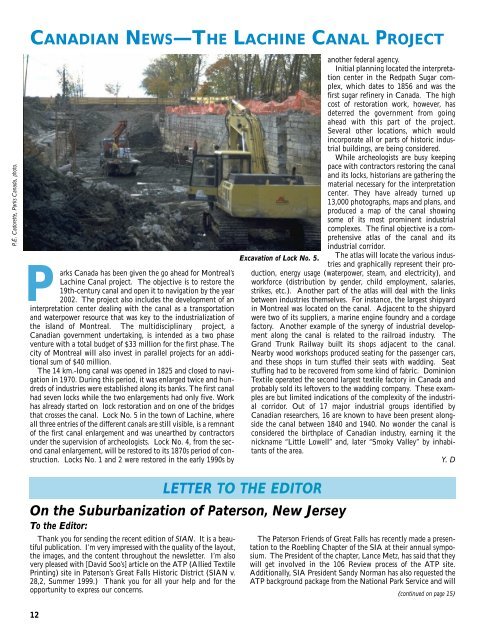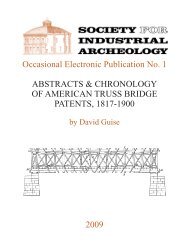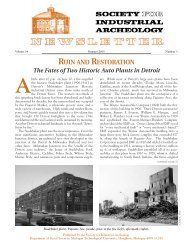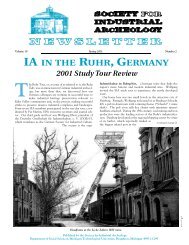birmingham, “pittsburgh of the south,” - Society for Industrial ...
birmingham, “pittsburgh of the south,” - Society for Industrial ...
birmingham, “pittsburgh of the south,” - Society for Industrial ...
You also want an ePaper? Increase the reach of your titles
YUMPU automatically turns print PDFs into web optimized ePapers that Google loves.
P.É. Cadorette, Parks Canada, photo.<br />
CANADIAN NEWS—THE LACHINE CANAL PROJECT<br />
Parks Canada has been given <strong>the</strong> go ahead <strong>for</strong> Montreal’s<br />
Lachine Canal project. The objective is to restore <strong>the</strong><br />
19th-century canal and open it to navigation by <strong>the</strong> year<br />
2002. The project also includes <strong>the</strong> development <strong>of</strong> an<br />
interpretation center dealing with <strong>the</strong> canal as a transportation<br />
and waterpower resource that was key to <strong>the</strong> industrialization <strong>of</strong><br />
<strong>the</strong> island <strong>of</strong> Montreal. The multidisciplinary project, a<br />
Canadian government undertaking, is intended as a two phase<br />
venture with a total budget <strong>of</strong> $33 million <strong>for</strong> <strong>the</strong> first phase. The<br />
city <strong>of</strong> Montreal will also invest in parallel projects <strong>for</strong> an additional<br />
sum <strong>of</strong> $40 million.<br />
The 14 km.-long canal was opened in 1825 and closed to navigation<br />
in 1970. During this period, it was enlarged twice and hundreds<br />
<strong>of</strong> industries were established along its banks. The first canal<br />
had seven locks while <strong>the</strong> two enlargements had only five. Work<br />
has already started on lock restoration and on one <strong>of</strong> <strong>the</strong> bridges<br />
that crosses <strong>the</strong> canal. Lock No. 5 in <strong>the</strong> town <strong>of</strong> Lachine, where<br />
all three entries <strong>of</strong> <strong>the</strong> different canals are still visible, is a remnant<br />
<strong>of</strong> <strong>the</strong> first canal enlargement and was unear<strong>the</strong>d by contractors<br />
under <strong>the</strong> supervision <strong>of</strong> archeologists. Lock No. 4, from <strong>the</strong> second<br />
canal enlargement, will be restored to its 1870s period <strong>of</strong> construction.<br />
Locks No. 1 and 2 were restored in <strong>the</strong> early 1990s by<br />
Thank you <strong>for</strong> sending <strong>the</strong> recent edition <strong>of</strong> SIAN. It is a beautiful<br />
publication. I’m very impressed with <strong>the</strong> quality <strong>of</strong> <strong>the</strong> layout,<br />
<strong>the</strong> images, and <strong>the</strong> content throughout <strong>the</strong> newsletter. I’m also<br />
very pleased with [David Soo’s] article on <strong>the</strong> ATP (Allied Textile<br />
Printing) site in Paterson’s Great Falls Historic District (SIAN v.<br />
28,2, Summer 1999.) Thank you <strong>for</strong> all your help and <strong>for</strong> <strong>the</strong><br />
opportunity to express our concerns.<br />
12<br />
ano<strong>the</strong>r federal agency.<br />
Initial planning located <strong>the</strong> interpretation<br />
center in <strong>the</strong> Redpath Sugar complex,<br />
which dates to 1856 and was <strong>the</strong><br />
first sugar refinery in Canada. The high<br />
cost <strong>of</strong> restoration work, however, has<br />
deterred <strong>the</strong> government from going<br />
ahead with this part <strong>of</strong> <strong>the</strong> project.<br />
Several o<strong>the</strong>r locations, which would<br />
incorporate all or parts <strong>of</strong> historic industrial<br />
buildings, are being considered.<br />
While archeologists are busy keeping<br />
pace with contractors restoring <strong>the</strong> canal<br />
and its locks, historians are ga<strong>the</strong>ring <strong>the</strong><br />
material necessary <strong>for</strong> <strong>the</strong> interpretation<br />
center. They have already turned up<br />
13,000 photographs, maps and plans, and<br />
produced a map <strong>of</strong> <strong>the</strong> canal showing<br />
some <strong>of</strong> its most prominent industrial<br />
complexes. The final objective is a comprehensive<br />
atlas <strong>of</strong> <strong>the</strong> canal and its<br />
industrial corridor.<br />
Excavation <strong>of</strong> Lock No. 5. The atlas will locate <strong>the</strong> various industries<br />
and graphically represent <strong>the</strong>ir production,<br />
energy usage (waterpower, steam, and electricity), and<br />
work<strong>for</strong>ce (distribution by gender, child employment, salaries,<br />
strikes, etc.). Ano<strong>the</strong>r part <strong>of</strong> <strong>the</strong> atlas will deal with <strong>the</strong> links<br />
between industries <strong>the</strong>mselves. For instance, <strong>the</strong> largest shipyard<br />
in Montreal was located on <strong>the</strong> canal. Adjacent to <strong>the</strong> shipyard<br />
were two <strong>of</strong> its suppliers, a marine engine foundry and a cordage<br />
factory. Ano<strong>the</strong>r example <strong>of</strong> <strong>the</strong> synergy <strong>of</strong> industrial development<br />
along <strong>the</strong> canal is related to <strong>the</strong> railroad industry. The<br />
Grand Trunk Railway built its shops adjacent to <strong>the</strong> canal.<br />
Nearby wood workshops produced seating <strong>for</strong> <strong>the</strong> passenger cars,<br />
and <strong>the</strong>se shops in turn stuffed <strong>the</strong>ir seats with wadding. Seat<br />
stuffing had to be recovered from some kind <strong>of</strong> fabric. Dominion<br />
Textile operated <strong>the</strong> second largest textile factory in Canada and<br />
probably sold its leftovers to <strong>the</strong> wadding company. These examples<br />
are but limited indications <strong>of</strong> <strong>the</strong> complexity <strong>of</strong> <strong>the</strong> industrial<br />
corridor. Out <strong>of</strong> 17 major industrial groups identified by<br />
Canadian researchers, 16 are known to have been present alongside<br />
<strong>the</strong> canal between 1840 and 1940. No wonder <strong>the</strong> canal is<br />
considered <strong>the</strong> birthplace <strong>of</strong> Canadian industry, earning it <strong>the</strong><br />
nickname “Little Lowell<strong>”</strong> and, later “Smoky Valley<strong>”</strong> by inhabitants<br />
<strong>of</strong> <strong>the</strong> area.<br />
Y. D<br />
LETTER TO THE EDITOR<br />
On <strong>the</strong> Suburbanization <strong>of</strong> Paterson, New Jersey<br />
To <strong>the</strong> Editor:<br />
The Paterson Friends <strong>of</strong> Great Falls has recently made a presentation<br />
to <strong>the</strong> Roebling Chapter <strong>of</strong> <strong>the</strong> SIA at <strong>the</strong>ir annual symposium.<br />
The President <strong>of</strong> <strong>the</strong> chapter, Lance Metz, has said that <strong>the</strong>y<br />
will get involved in <strong>the</strong> 106 Review process <strong>of</strong> <strong>the</strong> ATP site.<br />
Additionally, SIA President Sandy Norman has also requested <strong>the</strong><br />
ATP background package from <strong>the</strong> National Park Service and will<br />
(continued on page 15)






